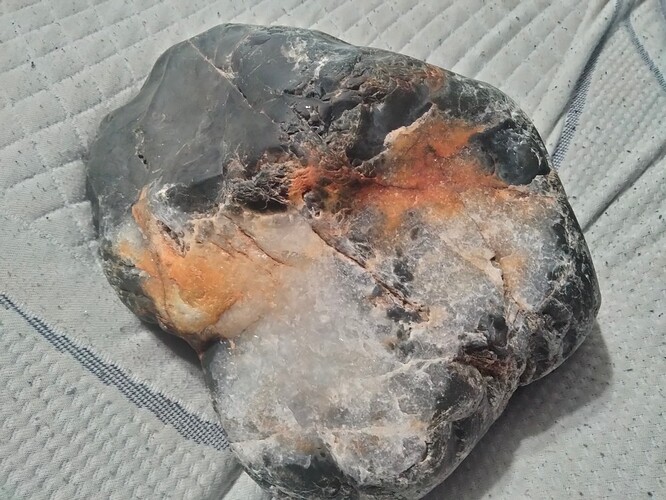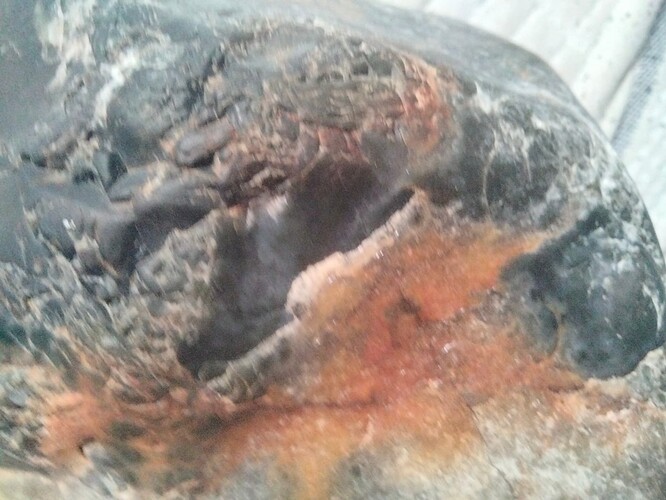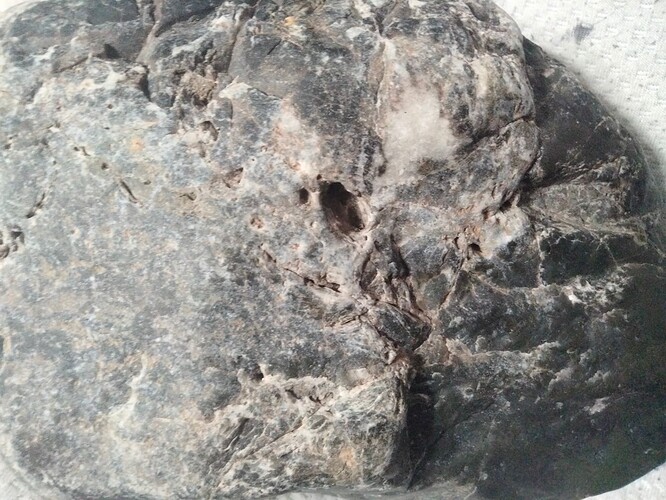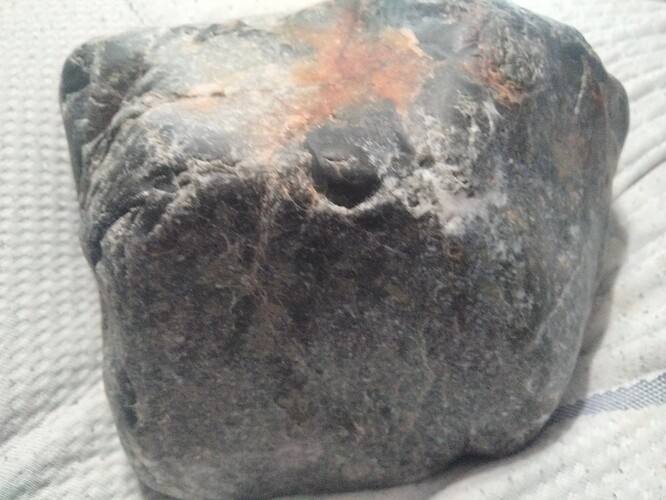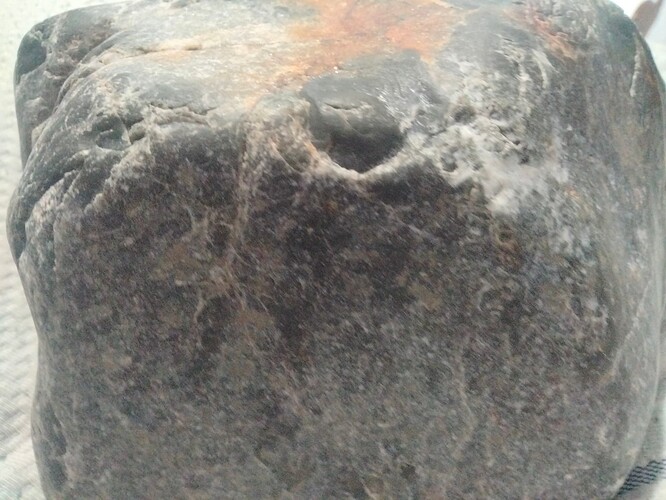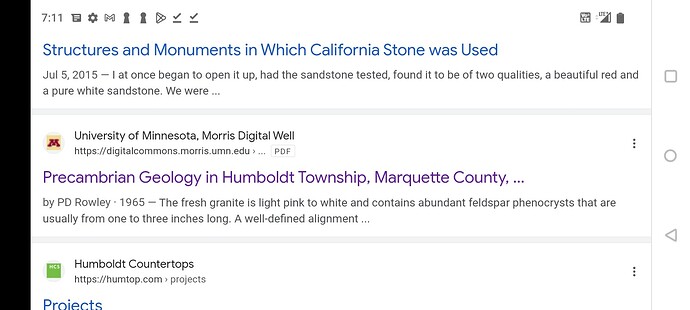Hi I bought something from someone on etsy. It was not what they said it was to my 100 percent belief. They agreed to let me pick something else out even if there was a chance I could have been incorrect. I picked out what the person thought was white granite from california. They found this on their property. When it came I did reachearch and white granite did not come from this part of california usa. White granite according me my reachearch does not come from usa. White jade and white jadeite does though and can look like white granite to me. Does anyone think this is white jade or white jadeite? Does anyone think this looks like jade? Thanks
Your rock could be limestone or a silicate, or perhaps silica itself; for example a microcrystalline quartz such as chert. If it’s limestone it will fizz with hydrochloric acid, and also be scratched by quartz. Your sample lacks mica and larger crystal form so is unlikely to be white granite. Your situation reminds me of a character in Australia called “Tinaroo” Ted. Last year he was selling tourists in Alice Springs what he claimed was white garnet but what in reality was simply white quartz. When challenged he wasn’t ashamed about the deception and didn’t stay around after the sale. Maybe he missed his opportunity to sell on Etsy.
Always remember that the first test on jade is what does it feel like. At room temperature it will be cool to the touch.
As from my experience it seams silt with some calcite due to metamorphism action.
With my XRF will be easy the composition of material.The declacaration from ETSY
from my experience is not reliable.
Happy for hlping you free.
dr. Piero Manuelli geologist and gemmologist FGA chairperson of italian ATC Gem-A (The Gemmological Association of grat Britain)
I’d agree with Ivan, it’s most likely a micro-crystalline quartz that has orangey red iron staining.
Test it …. Take something sharp. It it scratches, not jade. You wanted to by granite?
stainless Steel left a mark on the gemstone rock. It is hard to tell if it also scratched the gemstone for me though. The rock is cold to the touch all the time.
I have a question. why does not all micro-crystalline quartz have a specific shape? most quartz has a shape to it usually. It probably is quartz. I looked again, I think the stainless steel did scratch the gemstone as well, I used the side of sissors to do it. don’t know if you pressed on the stainless steel sissors pressing harder back and forth in the same spot would count for the hardness test or not. when i did that that is when I pretty sure that is when gemstone scratched.
I just varifed the scratch again. it is defentally scratching the white rock and leaving a scratch on the stainless steel sissors at the same time! I don’t know how this could be white granite though. It could have the hardness of 8… It would have been neat if it was jadeite. I think it only has a hardness of up to 7? I did run into some mica between the rock and gemstone. it made my hands dirty a bit. I hope i am identifying this hardness test correctly!
Simple recipe. Take a magnifying glass, a hammer and chisel, and eye protection. Place rock on hard support eg concrete. Insert chisel into crevice in rock and chip off a piece. If the chip has sharp edges and has a glassy fracture it is microcrystalline quartz. If the edge is ragged and the chip shows crystalline fracture it is likely limestone or felspar. If it is jadeite it won’t fracture unless there is already a definite fracture in the rock. If unsure place the chip alone in a microwave and heat for two minutes on high. If it is jadeite it will get hot.
Thank you for telling me all about the ways to tell the difference!
Please see the posts that I made in reference to your rock with fissure filling drusy crystals. All of what I posted to you applies to this rock also. It is extremely unlikely that this sample is jadeite. Jadeite only developes under special conditions: high pressure and low temperature metamorphism, called blueschist facies… this facies is typically found in subduction zone areas where there are paired belts of high temperature, low pressure metamorphism and further inland, a second belt of low temperature, high pressure metamorphism. The latter is not common geologically.
as a general rule, there is no jadeite in the US, with the exception of small deposits in California, Washington State and British Columbia…almost all of American jade is nephrite jade… it’s found in California and most notably in Wyoming, and Alaska. Jadeite in North America is found in Guatemala, the source of Mayan blue green jadeite which is highly prized and expensive.
I suggest that you do not buy rock samples online. You are not buying what sellers are telling what it is… it’s better to go and find your own rock samples.
So far as “white granite” is concerned, white granite is alkali feldspar, quartz, mica and biotite. There may be a lesser amounts of dark minerals besides biotite, including amphibole and garnet. The granite is white because the feldspar is lacking iron. Many granites have pink feldspar due to trace amounts of iron in the feldspar which gives it color.
What you have that is white looks like massive quartz, or crytocrystalline quartz. Quartz is so common in crustal rocks that it will occur in sedimentary rocks as chert within limestone, all kinds of metamorphic rocks and common granitic rocks. Again, I don’t think that buying rock samples online without verification is a good idea… what you have been buying and asking for identification are ordinary rock samples… I hope that you are not paying a premium price for any of them…
I cannot emphasize more: DO NOT buy rocks online especially from Etsy… Sellers may have acquired them from other sellers… the identification given with the rocks is NOT RELIABLE…
Rocks and mineral specimen should ALWAYS come with it’s locale…it doesn;t have to specific to the actual mine but must be specific to the area that it came from. Buy from a local rock shop… find them on your own by joining your local rock and mineral club…what you have shown looks like an ordinary rock that could be anything. It’s extremely difficult to impossible to identify massive rocks from pictures… they could be anything form metamorphic rock cobbles to massive quartz… the dark color doesn’t help a bit… one of the photos could be quartz druze with iron staining, otherwise any other ID by appearance alone is impossible.
If you know enough mineralogy to test it, start with scratch tests… a steel file is hard enough to scratch quartz… Mohs hardness 8 is approximated by a masonry drill bit… the Mohs scale is not linear… it’s roughly exponential… mineral reverence hardnesses vary by 25% harder up to 300% harder, with diamond being 3X or ore harder than corundum. Corundum comes in a cheap form as aluminum oxide knife sharpeners or grinding wheels…carborundum grinding wheels have a hardness of 9.5 and will scratch everything except of diamond… look at the color of the scratch mark… if the rock is hard and has a white scratch, it mostly likely massive quartz. Garnets have a hardness of 6.5 to 7.5… the streak will also be white, can’t easily distinguish garnet from quartz by scratch testing alone… However, there are no white garnets per se… all of them are colored by iron, manganese, magnesium, chromium… Black nephrite jade from Wyoming will not have drusy quartz associated with it,
Acid testing with dilute muriatic acid will cause calcite and other carbonate rocks to effervesce… carbonates however all all soft minerals… the will be scratched by a copper penny (pre 1981 pennies, new ones are copper plated zinc)… what you have is too dense looking to be a carbonate.
Bottom line: do not buy rocks online without a statement of type locale and verification don’t get ripped off for a garden variety common rock!!!
Thank you when I have bought from etsy before it is usually all from the same exact person. He kept records where he acquired every stone he had and how he came across it and it would come with a card of where it came from and stuff he knew about the specific stone he was selling. But your right in general. This particular white stone/ quartz something I got free of charge. Someone thought they sold me just green granite and it wasn’t when I got it. They sent this instead free of charge instead of a return. This was a different seller than I in the past got some stuff from usually. Thank you again
Please be informed that many stones and rock bought from Esty are simulants or different as composition. You can use a XRF instrument and you can reed immediately the composition of rock as chimical components.My be a gneiss or granite rock
these people did say they had their property in the mountains in California.
exactly where in California and do you trust them? Trust is more important than where… many who seem to be trustworthy aren’t… the appearance of trustworthiness is what scam artists thrive on… Caveat Emptor…also looks are deceiving… could just be a dark common quartzite…your sample if quartzite will have a hardness of 7 as quartz is at minimum 80% of quartzite… a simple scratch test is inadequate for rock identification. XRF will be accurate as to chemistry but won’t necessarily tell you about the mineralogy especially if this is a rock with multiple minerals and not a single mineral. It also requires specialized scientific equipment. So far as being white granite, this is not white granite either… white granites and have a granular texture due to an intergrowth of free quartz, alkali feldspar, and mica grains…usually some biotite as a mafic mineral. The Sierra Nevada is granitoid and not granite in the strict sense as it’s not alkali feldspar… plagioclase is present as the
se are calc-alkaline rocks. So far as it being Jadeite, I would think close to absolutely not…
There are geological reasons for thinking so… pictures are impossible to identity what is what with any degree of certainty unless it’s a perfect crystal of a single mineral… even that is not easy to identify… physical and chemical properties are what is most important as well as provenance…
You have to do your homework online before you buy online… I don’t buy online… I have to see, feel and inspect carefully myself… You also have to study enough geology, mineralogy to understand the scientific basis of rock and mineral identification… no one else can do that for you… unless you are willing and able to take university level courses in the subject and have a live teacher. Online searches are helpful but only if you know what questions to ask… the same rock or mineral can have many different appearances depending on habit, crystallinity and multiple other factors… that makes pictures nearly useless in specific rock and mineral ID…
I quote you
"Hi Jennifer! I found the garnet myself, on my partner and I’s property. Which is 40 acres in Humboldt county. About 2.5 hours outside of Eureka in the mountains. ". I have already asked them that question also!
They could be telling the truth. I found a website that says there is white granite their in that area.
Humboldt county is very interesting geologically as it has exposures of precambrian rocks, both of igneous and metamorphic origin. In addition, there are 4 ophiolites that extend from that area into the Klamath mountains of OR… A variety of rock types will be found there.
You really should break the specimen open to expose a fresh, unweathered surface that you can look at closely using a magnifier…
What you have is definitely not white granite so far as I can see from the picture… the surfaces are weathered somewhat making it hard to really see the fresh rock. so I can’t be absolutely sure.
I strongly recommend that you buy and study Simon and Schuster’s “field guide to mineral and rocks” This book does have a ton of information in it along with pictures of classic rock and mineral specimens… I did say that pictures are not helpful but in this case they are, since the pictures all are of fresh material with classic appearances. Chemistry, physical properties, crystal group and other mineralogical data, along with type locale are all listed. In the rock section of the book, constituent mineral and conditions of formation are listed along with chemical data, mineralogy of the rock.
There also is a companion field guide to gems in the series… you can cross reference them back to the minerals section of the field guide. the gem book lists minerals that make up gems again along with native samples in matix and cut samples. Chemical, optical, crystal class, and other physicochemical properties are listed. A modern edition of Dana’s Mineralogy is also indispensable. The original mineral classification scheme as put forth by Dana who was an early 20th century mineralogist, has still been kept with minerals classified starting with native elements, sulfides, oxides, going thru the silicates. Again, physicochemical properties are listed along with photos which are classic for each mineral. Classic type locales are always included, as is with the data from all of the books. These books are a great place for a beginner to start learning about mineralogy and rocks. The latter is more complicated since rocks are made up of minerals…the minerals in a rock tell you what kind of rock it is. Some minerals are complete incompatible with others so they are never found in the same rock…I think that these books are a great place to start for any beginner. Experienced geologists can refer to them also in the field.
I always break open a rock sample in the field…I take a hammer and chisel… sometimes it takes a 3 lb sledge hammer to break off a piece or to crack a rock open…In the field I carry a hammer and chisel. If I pick up something without breaking it open, I take it home to break it open. All rocks have a weathered surface… the surface weathering makes it very difficult to identify. A fresh surface is what is needed to closely inspect visually and with a magnifying lens to see mineral grains within a rock. weathering can penetrate deeply into some rocks that are less resistant to weathering than others…sometimes a specimen is weathered all the way thru… In that case it will be difficult to identify anything unless there has been secondary mineral deposition… that makes it difficult also since secondary mineralization is often very fine grained, amorphous and nonspecific to a rock type. In your case, you have a sample that looks very felsic or quartz rich… quartzites and cryptocrystalline forms of quartz are very resistant to weathering… cracking it open will give you a lot more information… just the fracture pattern will tell you a lot… However, the raw specimen still shows some surface weathering and discoloration from iron staining. If you crack it open and find that the mineral grains are very small, then you will need a loup or a stereomicroscope to look at the grains and try to identify what mineral they are. Some rocks are very fined grained… they cannot be identified except by thin section light microscopy with polarizing filters to identify the mineral constituents. glassy rocks like obsidian have to grains and no crystal structure.
The bottom line is that you need to have a good set of beginning reference and textbooks to start your study of rocks and minerals. Either that or take a intro to rocks and minerals at your local college. Having a teacher and a didactic session along with a hands on rock ID lab will help you understand how complicated the world or rocks and minerals can be and also how simple it can be…
